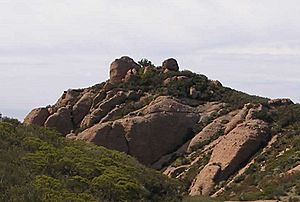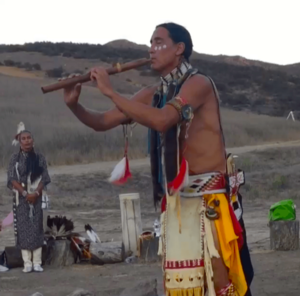Satwiwa facts for kids
| Established | 1980 |
|---|---|
| Location | 4126 1 W. Potrero Road, Newbury Park, CA 91320 |
| Type | Culture Center National Park |
| Public transit access | Thousand Oaks Transit (TOT) |
Satwiwa (which means "the bluffs" in the Chumash language) was once a Chumash village. It is located in the beautiful Santa Monica Mountains near Newbury Park, California. Today, it is home to the Satwiwa Native American Indian Culture Center.
The National Park Service works with the Friends of Satwiwa to run the center. Chumash people have lived in this area for over 10,000 years. Satwiwa sits at the base of Boney Mountain, a very special and sacred place for the Chumash.
This area borders huge wilderness lands in the Santa Monica Mountains. You can find amazing animals here. These include golden eagles, mountain lions, coyotes, snakes, bobcats, and foxes.
Satwiwa is also known as a main entrance to the Santa Monica Mountains National Recreation Area. Many trails here lead into the wilderness.
Contents
What Does Satwiwa Mean?
The name Satwiwa comes from the Chumash language. It means "the bluffs" or "higher places." This name first referred to the nearby Boney Mountain. Satwiwa was also the name of an old Chumash village. This village was located close to where the culture center is now. It was just north of Big Sycamore Canyon in Newbury Park, California.
Exploring the Satwiwa Culture Center
Satwiwa is right next to the Santa Monica Mountains and Rancho Sierra Vista. It is part of the larger Santa Monica Mountains National Recreation Area. This special place is at the western end of the Santa Monica Mountains. It borders land managed by the National Park Service.
Chumash people have lived in Satwiwa and the surrounding areas for over 10,000 years. The old village site has been turned into a nature center. It has a special area that shows what a Chumash Indian village was like. On weekends, Native American guides or park rangers are there to teach visitors. The center also hosts art shows, ceremonies, and hands-on exhibits. You can find hiking trails that connect to Point Mugu State Park. Some trails even lead to beautiful waterfalls in the Santa Monica Mountains.
Satwiwa and the nearby Point Mugu State Park cover 16,000 acres. The word "Mugu" comes from the Chumash word "muwu," meaning "beach." The landscape here is stunning. It features the dramatic Boney Mountain, rocky canyons, and coastal plants. You'll see creekbeds, oak and sycamore trees, and rolling green hills. Many trails connect to other open-space areas.
A Look Back: History of Satwiwa
Native Americans have called this area home for more than 10,000 years. They lived by hunting and gathering food. They fished in the Pacific Ocean and hunted deer and rabbits in the canyons. They also collected acorns from oak trees. These acorns were ground into food, often mixed with roots or berries. These tribes were part of a busy trade network. This network stretched along the coast and even to the California Channel Islands.
In the mid-1500s, Spanish explorers arrived. They were the first Europeans to meet the native people. The Spanish built missions nearby to claim the land for Spain. When the Spanish arrived, the village of Satwiwa became part of Rancho El Conejo.
Today, Native Americans from Chumash, Tataviam, Tongva, and Vanyume families keep their traditions alive. They organize programs at the Satwiwa Center. They share their culture through art, displays, and modern programs. Traditional ceremonies and dances are still held at the center.
The U.S. National Park Service bought the Satwiwa site in 1980. They then developed the cultural center there. The Satwiwa Native American Indian Culture Center is a partnership. It is run by the Chumash people and the U.S. National Park Service. The center offers many educational talks and workshops. It also features Native American art displays.
The Chumash People and Satwiwa
The Ventureño Chumash Indians first settled in Satwiwa about 13,000 years ago. They lived in the village as recently as 2,000 years ago. The village was a stop for travelers and traders. These people crossed the Santa Monica Mountains through Sycamore Canyon. They traveled from the Conejo Valley to the Mugu Lagoon and the Pacific Ocean. The Chumash traded with the Gabrieleño-Tongva Indians, who lived in Los Angeles County.
Many Chumash artifacts and petroglyphs (rock carvings) have been found nearby. These are especially common along the Arroyo Conejo. This creek flows to its estuary in the Mugu Lagoon. Satwiwa is at the base of Boney Mountain. This mountain is very sacred to the Chumash people. Many artifacts are on display at the Satwiwa Native American Indian Culture Center. You can also see them at the Chumash exhibit at the Stagecoach Inn Museum in Newbury Park. The Chumash Indian Museum in Thousand Oaks also has displays.
Native American groups still use Satwiwa regularly. The Chumash Barbareño-Ventureño Band of Mission Indians holds events there. These include community dancing and celebrations. They celebrate ceremonies like the summer solstice and the Hutash ceremony.
The first people of Satwiwa believed Boney Mountain was the sacred home of all creation. The peak is still sacred to the Chumash today. The cultural center has a reconstructed Chumash village. It sits across the path from the main center. This village shows traditional ‘ap (houses). It is especially popular on weekends. That's when Native American teachers and National Park rangers are there.
Fun Activities and Recreation
Point Mugu State Park has over 100 miles of trails. It is one of California's largest state parks. Almost half of the park is the Boney Mountain State Wilderness Area. This wild area surrounds Mount Boney, a sacred mountain for the Chumash people.
Many trails lead to waterfalls and mountain views. Some trails cross the Santa Monica Mountains to the coast of Point Mugu. The Old Boney Loop trail goes from Satwiwa into the heart of the Boney Mountain wilderness. A shorter hike is to Sycamore Canyon Waterfall. This hike is 3.5 miles roundtrip from the Satwiwa Native American Culture Center. Sycamore Canyon Waterfall has a 70-foot series of cascades. It is near a creek bed covered with trees.
There are many trails in the area that connect to each other. Runners, hikers, horseback riders, and mountain bikers all use these trails.
Wildlife at Satwiwa
Satwiwa is next to Santa Monica Mountains National Recreation Area land. Because of this, there is a lot of wildlife nearby. You might see rabbits, coyotes, deer, and prairie falcons. Roadrunners, hawks, golden eagles, foxes, and raccoons are also common.
The area is also home to rattlesnakes and mountain lions.
Mammals of the Santa Monica Mountains
The Santa Monica Mountains National Recreation Area (SMMNRA) is home to more than 45 types of mammals. Here are some of the mammals you can find there:
- Virginia opossum
- California raccoon
- American badger
- Gray fox
- Valley coyote
- Red fox
- Bobcat
- Mountain lion
- Ring-tailed cat
- Striped skunk
- Spotted skunk
- Long-tailed weasel
- Black-tailed jackrabbit
- Desert cottontail
- Brush rabbit
- Mule deer
- Western gray squirrel
- Fox squirrel
- California ground squirrel
- Merriam's chipmunk
- Botta's pocket gopher
- Desert shrew
- Ornate shrew
- Broad-footed mole
- Pallid bat
- Big brown bat
- Hoary bat
- California myotis
- Yuma myotis
- Western pipistrelle
- Western mastiff bat
- Mexican free-tailed bat
- Pacific kangaroo rat
- California pocket mouse
- California vole
- Dusky-footed woodrat
- Desert woodrat
- Brush mouse
- California mouse
- Cactus mouse
- House mouse
- Deer mouse
- Pinyon mouse
- Western harvest mouse
- Brown rat
- Black rat






